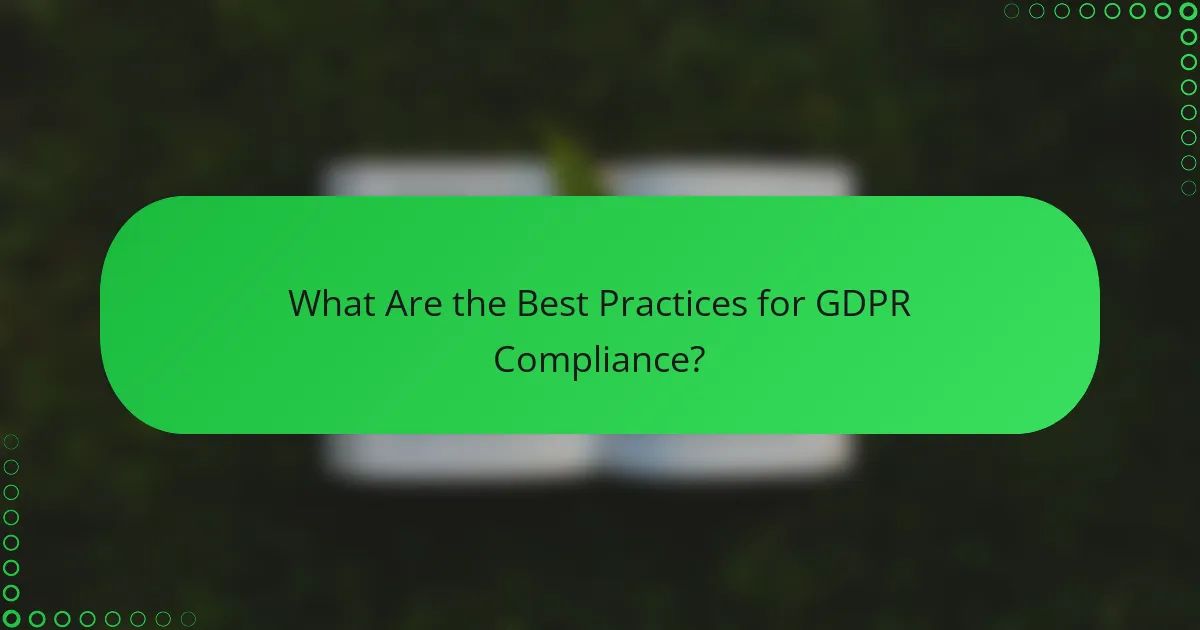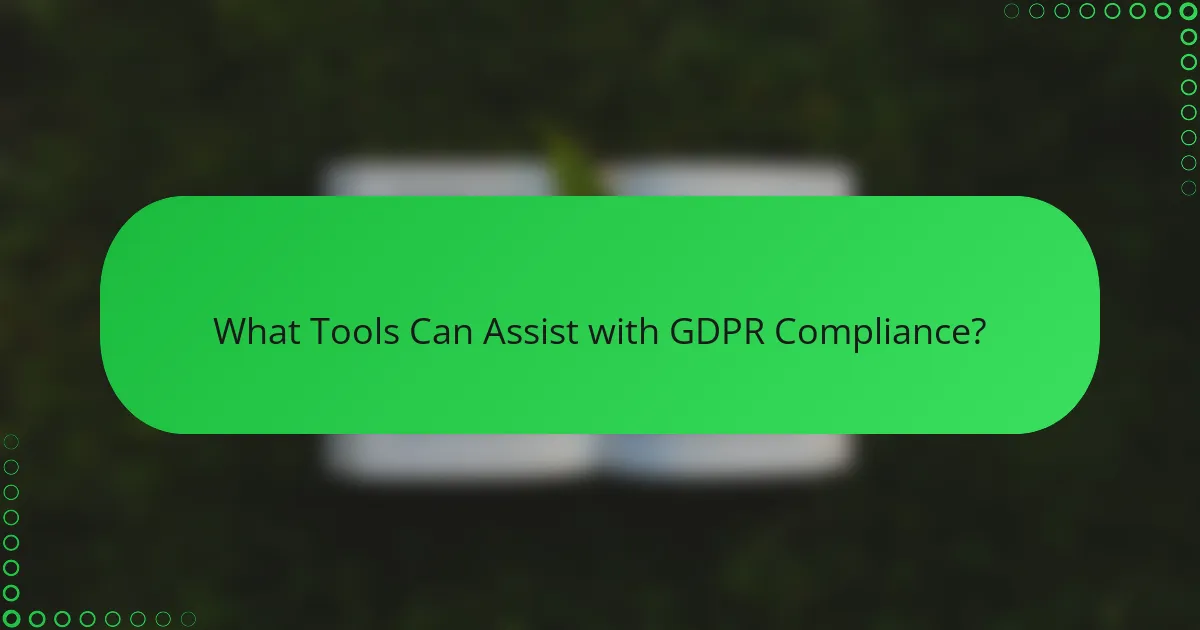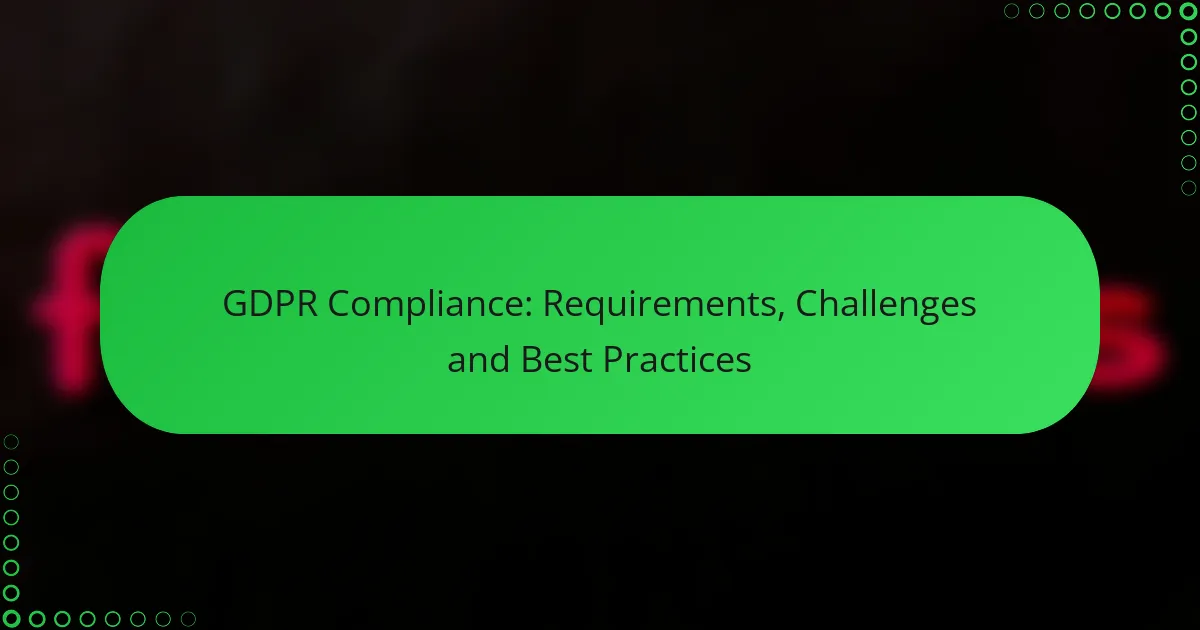The General Data Protection Regulation (GDPR) establishes essential requirements for organizations to safeguard personal data, emphasizing the rights of individuals and the importance of data protection principles. Achieving compliance involves navigating complex regulations, conducting thorough data audits, and implementing effective privacy policies and employee training. For those interested in enhancing their understanding of this topic, exploring Cloud Gaming Security and Privacy can provide valuable insights. Organizations face challenges such as resource allocation and maintaining data security while striving to meet these stringent standards.

What Are the Key GDPR Compliance Requirements?
The General Data Protection Regulation (GDPR) outlines several key compliance requirements that organizations must follow to protect personal data. These requirements focus on data protection principles, the rights of data subjects, data processing agreements, breach notifications, and impact assessments.
Data Protection Principles
The GDPR establishes fundamental principles for data protection that organizations must adhere to. These include lawfulness, fairness, and transparency in processing personal data, as well as limiting data collection to what is necessary for specific purposes.
Organizations should ensure that personal data is accurate and kept up to date, and that it is retained only for as long as necessary. Implementing these principles helps build trust with customers and reduces the risk of non-compliance.
Rights of Data Subjects
Under the GDPR, individuals have specific rights regarding their personal data. These rights include the right to access their data, the right to rectify inaccuracies, and the right to erase data under certain conditions.
Organizations must have processes in place to facilitate these rights, such as providing clear information on how individuals can exercise them. Failing to respect these rights can lead to significant penalties and damage to reputation.
Data Processing Agreements
Data processing agreements (DPAs) are essential for organizations that engage third parties to process personal data on their behalf. These agreements must outline the responsibilities and obligations of both parties regarding data protection.
It is crucial to ensure that DPAs include clauses on data security, confidentiality, and the handling of data breaches. Regular reviews of these agreements can help maintain compliance and protect against legal risks.
Data Breach Notification
The GDPR mandates that organizations must notify relevant authorities and affected individuals of a data breach within 72 hours of becoming aware of it. This requirement emphasizes the importance of having a robust incident response plan in place.
Organizations should document the breach’s nature, its impact, and the measures taken to address it. Failure to comply with notification requirements can result in hefty fines and legal consequences.
Data Protection Impact Assessments
Data protection impact assessments (DPIAs) are required when processing activities are likely to result in a high risk to individuals’ rights and freedoms. Conducting a DPIA helps organizations identify and mitigate risks associated with data processing.
Organizations should involve relevant stakeholders in the DPIA process and document findings and actions taken. This proactive approach not only aids compliance but also enhances data protection strategies overall.

How to Achieve GDPR Compliance?
Achieving GDPR compliance involves understanding and implementing several key requirements to protect personal data. Organizations must focus on data audits, privacy policies, employee training, and the use of compliance tools to ensure they meet the regulation’s standards.
Conduct a Data Audit
A data audit is essential for identifying what personal data your organization holds, how it is processed, and where it is stored. Begin by cataloging all data sources, including databases, cloud storage, and third-party services.
Assess the legal basis for processing each type of data, ensuring that you have consent or another valid reason. This audit will help you pinpoint areas that require changes to comply with GDPR.
Implement Privacy Policies
Clear and transparent privacy policies are critical for GDPR compliance. These policies should outline how personal data is collected, used, and protected, as well as the rights of individuals regarding their data.
Ensure that your privacy policy is easily accessible and written in plain language. Regularly review and update it to reflect any changes in data processing activities or legal requirements.
Train Employees on GDPR
Employee training is vital for fostering a culture of data protection within your organization. Conduct regular training sessions to educate staff about GDPR principles, data handling procedures, and the importance of safeguarding personal data.
Consider using real-life scenarios to illustrate potential compliance issues and best practices. Regular refresher courses can help keep GDPR awareness high among employees.
Utilize GDPR Compliance Tools
Various tools are available to assist organizations in achieving GDPR compliance. These tools can help automate data mapping, consent management, and breach notifications, making compliance more manageable.
Evaluate different software solutions based on your organization’s size and specific needs. Look for tools that offer features like data encryption, access controls, and audit trails to enhance your compliance efforts.

What Are the Common Challenges in GDPR Compliance?
Common challenges in GDPR compliance include understanding complex regulations, allocating sufficient resources, and maintaining data security. Organizations often struggle to interpret the requirements and implement necessary changes effectively.
Understanding Complex Regulations
GDPR regulations are intricate and can be challenging to navigate. Organizations must familiarize themselves with various aspects such as data subject rights, consent requirements, and the principles of data processing. Misinterpretation can lead to non-compliance and significant fines.
To tackle this, businesses should consider engaging legal experts or consultants who specialize in GDPR. Regular training sessions for employees can also help ensure everyone understands their responsibilities under the regulation.
Resource Allocation for Compliance
Effective GDPR compliance requires adequate resource allocation, including financial, human, and technological investments. Many organizations underestimate the budget needed for compliance initiatives, which can lead to rushed or incomplete implementations.
It is advisable to conduct a thorough assessment of current resources and identify gaps. Setting aside a dedicated budget for compliance activities and hiring or training staff with GDPR expertise can significantly enhance compliance efforts.
Maintaining Data Security
Data security is a critical component of GDPR compliance, as organizations must protect personal data from breaches. Implementing robust security measures, such as encryption and access controls, is essential to safeguard sensitive information.
Regular audits and assessments of security practices can help identify vulnerabilities. Additionally, organizations should establish an incident response plan to address potential data breaches promptly and effectively, minimizing the impact on affected individuals and the organization itself.

What Are the Best Practices for GDPR Compliance?
Best practices for GDPR compliance involve implementing systematic processes to ensure data protection and privacy. Organizations should focus on regular assessments, legal consultations, and thorough documentation of data handling procedures.
Regular Compliance Reviews
Conducting regular compliance reviews is essential for maintaining GDPR adherence. These reviews should assess current practices against GDPR requirements, identifying any gaps or areas for improvement.
Organizations can schedule these reviews quarterly or biannually, depending on the volume of data processed and the complexity of operations. A checklist can help streamline the review process, ensuring all aspects of compliance are covered.
Engage with Legal Experts
Engaging with legal experts specializing in data protection is crucial for effective GDPR compliance. These professionals can provide tailored advice on navigating the complexities of the regulation and help interpret its implications for your organization.
Consider establishing a relationship with a legal consultant or law firm that has a strong track record in GDPR matters. This can be particularly beneficial when launching new data processing activities or when facing potential breaches.
Document Data Processing Activities
Documenting data processing activities is a fundamental requirement under GDPR. Organizations must maintain detailed records of what data is collected, how it is used, and the legal basis for processing.
This documentation should be clear and accessible, allowing for easy review during audits. Utilizing templates or software solutions can simplify this task and ensure that all necessary information is captured accurately.

How to Select GDPR Compliance Training Courses?
Selecting GDPR compliance training courses involves assessing the course content, instructor credentials, and format to ensure they meet your organization’s needs. A well-chosen course can effectively equip your team with the necessary knowledge to comply with GDPR regulations.
Evaluate Course Content
When evaluating course content, ensure it covers key GDPR principles such as data protection rights, consent requirements, and data breach protocols. Look for courses that provide practical examples and case studies to illustrate these concepts in real-world scenarios.
Check if the course aligns with your industry’s specific compliance needs. For instance, sectors like finance or healthcare may require more specialized training due to their unique data handling practices.
Check Instructor Credentials
Instructor credentials are crucial for effective training. Verify that the instructor has relevant experience in GDPR compliance, such as working with data protection authorities or serving as a compliance officer.
Consider instructors who have published articles or conducted workshops on GDPR. Their practical insights can enhance the learning experience and provide valuable perspectives on compliance challenges.
Consider Course Format
The course format can significantly impact learning outcomes. Options include in-person workshops, online webinars, or self-paced e-learning modules. Choose a format that fits your team’s schedule and learning preferences.
For remote teams, online courses with interactive elements, such as quizzes and discussion forums, can be particularly effective. Ensure the course provides access to materials for future reference, which can be beneficial for ongoing compliance efforts.

What Tools Can Assist with GDPR Compliance?
Several tools can help organizations achieve GDPR compliance by streamlining processes, managing data, and ensuring accountability. These tools range from data mapping software to consent management platforms, each addressing specific compliance needs.
Data Mapping Tools
Data mapping tools help organizations visualize and document the flow of personal data within their systems. By identifying where data is collected, stored, and processed, companies can better understand their data landscape and ensure compliance with GDPR requirements.
When selecting a data mapping tool, consider features such as automated data discovery, integration capabilities with existing systems, and user-friendly interfaces. Popular options include OneTrust and TrustArc, which offer comprehensive solutions for data mapping and compliance reporting.
Consent Management Platforms
Consent management platforms (CMPs) are essential for obtaining and managing user consent for data processing activities. These tools allow businesses to create customizable consent forms, track user preferences, and ensure that consent is recorded in compliance with GDPR standards.
Look for CMPs that provide clear opt-in and opt-out options, detailed reporting features, and easy integration with websites and applications. Examples include Cookiebot and ConsentManager, which help organizations maintain transparency and build trust with users.
Privacy Impact Assessment Tools
Privacy impact assessment (PIA) tools assist organizations in evaluating the potential risks associated with data processing activities. Conducting a PIA is a proactive step to identify and mitigate privacy risks before they become issues.
Choose PIA tools that offer templates for assessments, risk scoring mechanisms, and recommendations for risk mitigation. Tools like Nymity and TrustArc can facilitate the PIA process, ensuring that organizations remain compliant while protecting user data.
Data Protection Management Software
Data protection management software helps organizations implement and maintain their data protection policies and procedures. These tools typically include features for incident management, policy creation, and compliance tracking.
When evaluating data protection management software, consider options that offer robust reporting capabilities, user training resources, and support for GDPR-specific requirements. Solutions like Vanta and SAI Global can streamline compliance efforts and enhance data security.
